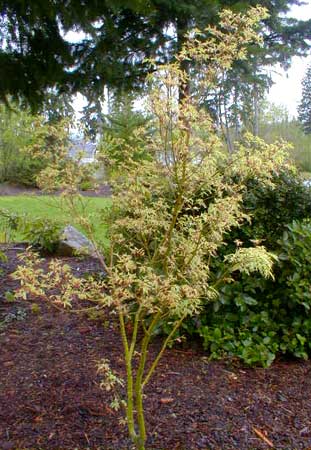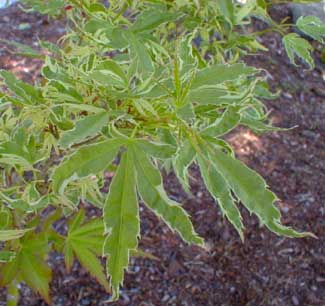
'Butterfly' Variegated Japanese Maple
Her teacher's certainty it must be Mabel
Made Maple first take notice of her name.
She asked her father & he told her, "Maple --
Maple is right."
"But teacher told the school
There's no such name."
"Teachers don't know as much
As fathers about children, you tell teacher.
You tell her that it's M-A-P-L-E.
Your mother named you. You & she just saw
Each other in passing in the room upstairs,
One coming this way into life, & one
Going the other out of life -- you know?
So you can't have much recollection of her.
She had been having a long look at you.
She put her finger in your cheek so hard
It must have made your dimple there, & said,
'Maple.' I said it too: 'Yes, for her name.'
She nodded. So we're sure there's no mistake.
-Robert Frost
(1874-1963)
(1874-1963)
'Butterfly' variegated Japanese maple wants a bright-shade area & can be leaf-burned in too much sun.
It is hardy & reliable, with leaves a light green or bluish grey-green, edged in white. Variegation can have a different effect tree to tree & even on a single tree month to month. The white portion often has tinges of pink in early spring, magenta in autumn, but in the main this is green & white variegation.
Its early spring flowers are bright red but very small & only of interest with close inspection.
 The tree's form tends to be upright, vase-shaped, & narrow. It is slow growing to about ten feet high in ten years, eventually as high as fifteen or even twenty feet though such big specimens are not often encountered.
The tree's form tends to be upright, vase-shaped, & narrow. It is slow growing to about ten feet high in ten years, eventually as high as fifteen or even twenty feet though such big specimens are not often encountered.As it matures it gets more densely leafed & broader, so that a ten-foot high specimen can be six or eight feet wide; but for a long while it will be narrow & delicately twiggy.
'Butterfly' is a recipient of the Award of Garden Merit from the Royal Horticultural Society, & the Award of Merit from The Netherlands. It was developed at Koichiro Wada Nursery in Japan.
Reliable records date it only to 1938, but it is believed really to be a much older cultivar. It is of the "Matsurmurai Group," that is, of the subspecies A. palmatum matsumurae which has given rise to so many uniquely colored cultivars, some of them so unusual one to the next it seems difficult to fathom how they could all be Matsumuraes. They have in common deeply cut leaf lobes, divided at least two-thirds the length of the leaves.
I photographed 'Butterfly' at a friend's house where I do some landscaping. It is shaded by Douglas fir & a Western cedar, so it has the protection it prefers, but very bright for shade.
It is shown in the first photo before mid-April when leaves are just emerging but not yet very large. The second photo shows the maturing leaves with creamy-white margins.
Like all Japanese maples, it wants moist well-drained acid humusy soil. It can be grown in zones six through eight. Japanese maples are very hardy trees for the Pacific Northwest though in zones less moderate in their winter & summer temperatures, they can be difficult.